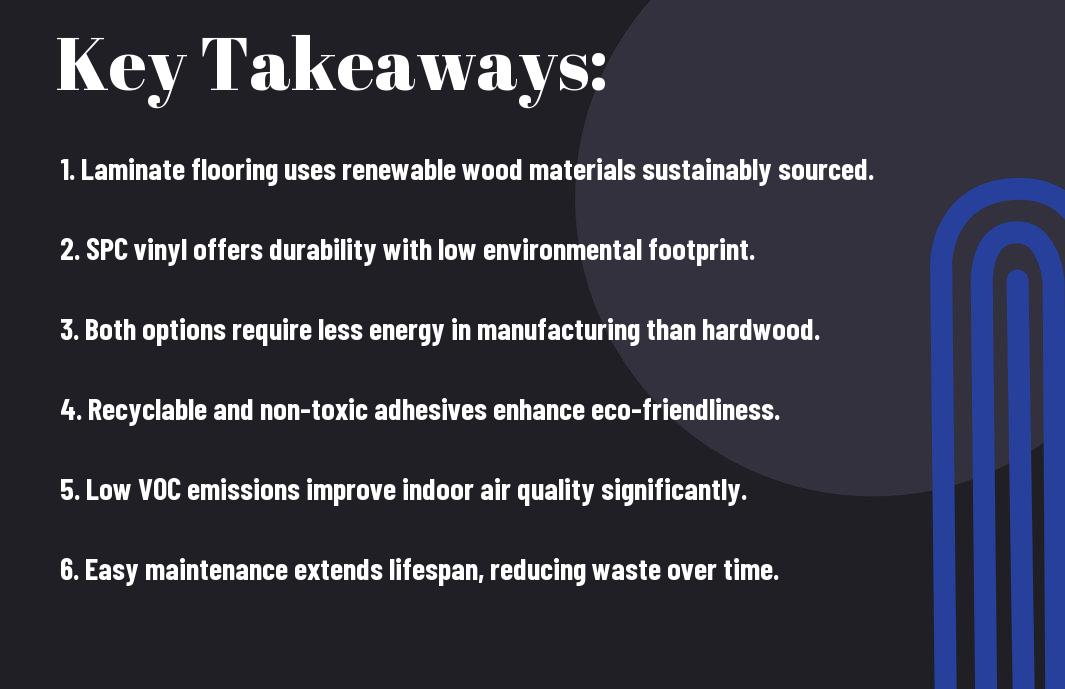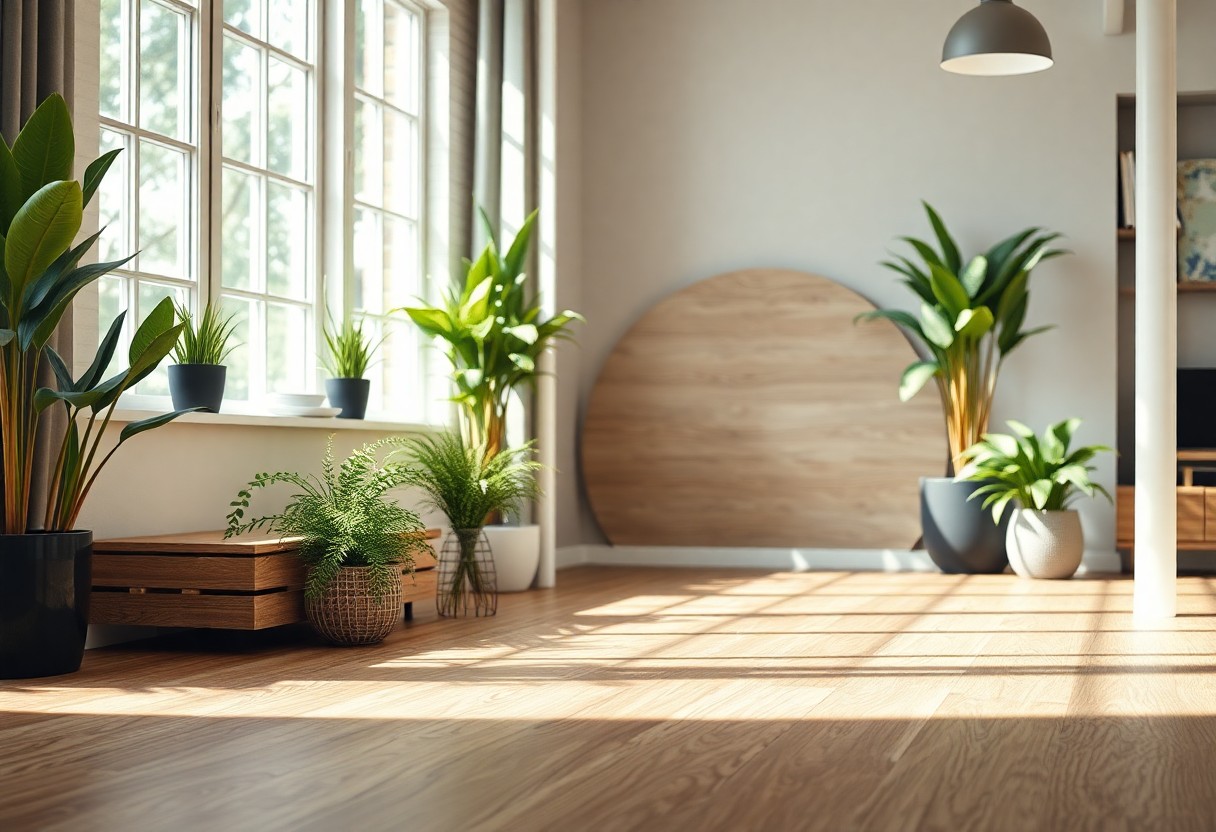Eco-friendly flooring options have become increasingly important as you seek to make more sustainable choices for your home. Laminate and SPC (Stone Plastic Composite) vinyl flooring offer durable, stylish, and environmentally responsible alternatives to traditional flooring. By exploring these options, you can reduce your ecological footprint while still achieving the aesthetic you desire. In this post, you will discover how laminate and SPC vinyl flooring can align with your commitment to sustainability, ensuring that your home remains beautiful and environmentally conscious.
Understanding Sustainable Flooring
For homeowners and builders alike, the choice of flooring goes beyond aesthetics and durability. Sustainable flooring options like laminate and SPC (Stone Plastic Composite) vinyl contribute to environmental conservation and healthier living spaces. By opting for eco-friendly materials, you not only reduce your carbon footprint but also support responsible production practices, ensuring that future generations can enjoy a healthier planet.
Definition of Eco-Friendly Flooring
Understanding eco-friendly flooring means recognizing materials that are made from sustainable resources, minimize environmental impact during production, and promote longevity. These options often utilize recycled content or materials sourced from responsibly-managed forests, ensuring that they align with your environmental values. By selecting these types of flooring, you are making a conscious choice that benefits both you and the planet.
Importance of Sustainability in Flooring Choices
Along with aesthetic appeal, choosing sustainable flooring options significantly impacts your overall indoor environment and the planet’s health. Sustainable flooring emits fewer harmful chemicals, providing a healthier living space. Moreover, by selecting products made from recycled or sustainably sourced materials, you actively participate in reducing waste and promoting conservation. This decision not only benefits you but also supports a more sustainable economy.
Importance extends beyond your immediate home; it encompasses a commitment to the planet’s future. When you choose eco-friendly flooring, you contribute to reducing landfill waste, conserving natural resources, and lowering energy consumption during production. These choices reflect your values and responsibility towards creating a more sustainable and environmentally-friendly world, inspiring others to follow suit in their home improvement projects.


Laminate Flooring: Eco-Friendly Features
You might be surprised to learn that laminate flooring offers a range of eco-friendly features that can enhance your home’s sustainability. Many manufacturers focus on using renewable resources and low-emission materials, ensuring that laminate can be a greener alternative to traditional flooring options. With advancements in technology and production, you can now find laminate that boasts impressive durability while also being kinder to the environment.
Materials Used in Sustainable Laminate
Around the world, laminate flooring is being crafted with sustainable materials such as recycled wood fibers and low-VOC (volatile organic compound) adhesives. By prioritizing these eco-friendly components, manufacturers ensure that their products not only look great but also reduce the overall environmental footprint. Choosing laminate made from responsibly sourced materials can make a significant difference in your sustainable living efforts.
Production Process and Its Environmental Impact
By embracing environmentally responsible manufacturing practices, the laminate flooring industry is significantly reducing its ecological impact. Key strategies include utilizing energy-efficient production techniques and implementing waste-reduction measures during the manufacturing process. This commitment to sustainability not only conserves resources but also minimizes harmful emissions associated with traditional flooring production.
With advancements in production methods, laminate flooring now boasts environmentally friendly processes that prioritize sustainability. For instance, many companies utilize renewable energy sources in their factories, which helps lower carbon emissions. Additionally, innovations like closed-loop systems closely manage waste and repurpose byproducts, resulting in minimal environmental impact. This continuous improvement in the laminate flooring industry resonates positively with eco-conscious consumers, providing you with both beautiful flooring options and a commitment to environmental stewardship.
SPC Vinyl Flooring: A Sustainable Alternative
Despite the growing concerns about environmental impact, SPC vinyl flooring emerges as a sustainable choice. Made from natural limestone and other eco-friendly materials, this flooring option not only enhances the aesthetic value of your space but also promotes a healthier planet. With minimal formaldehyde emissions, it far surpasses traditional vinyl alternatives, making it an excellent option for environmentally conscious consumers.
Composition and Benefits of SPC Vinyl
Among the features that make SPC vinyl flooring appealing, its composition stands out. The core consists of a blend of limestone and PVC, which results in exceptional durability, water resistance, and minimal environmental impact. Unlike conventional flooring materials, SPC vinyl is free from harmful chemicals, ensuring a safer indoor air quality for you and your family.
Comparison with Traditional Vinyl Flooring
For those considering eco-friendly flooring options, it’s necessary to understand how SPC vinyl stacks up against traditional vinyl flooring. The table below outlines the differences between these two choices.
| SPC Vinyl Flooring | Less waste in manufacturing and lower carbon footprint. |
| Traditional Vinyl Flooring | Higher levels of harmful chemicals and emissions. |
Consequently, SPC vinyl offers a far superior profile compared to traditional vinyl flooring. By choosing SPC, you not only invest in a more durable and resilient product but also contribute to a reduction in environmental pollution. The transformation of raw materials into eco-friendly solutions underscores SPC vinyl’s commitment to sustainability, making it a compelling choice for your flooring needs.
| SPC Vinyl Flooring | Lower maintenance and longer lifespan save resources. |
| Traditional Vinyl Flooring | Shorter lifespan leads to more frequent replacements. |
Certifications and Standards for Sustainable Flooring
Keep in mind that selecting flooring with recognized certifications can significantly influence your choice for sustainability. These standards ensure that the materials used in laminate and SPC vinyl flooring meet specific environmental and health requirements, allowing you to make conscientious choices for your home or project.
Key Eco-Certifications to Look For
About eco-certifications, it’s vital to be aware of labels like GREENGUARD, FloorScore, and FSC. These certifications indicate that the flooring products have undergone rigorous testing for emissions and responsible sourcing, ensuring they contribute to a healthier indoor environment and promote sustainable forestry practices in your living spaces.
Understanding the Impact of Certifications
Certifications provide valuable insight into the environmental impact of your flooring choices. They often reflect a commitment to sustainability, indicating that manufacturers strive to minimize their ecological footprint. By choosing certified products, you support brands dedicated to ethical practices and promote a healthier planet.
Even small decisions, like your choice in flooring, can have a ripple effect on the environment. Opting for certified products signals to manufacturers that sustainable practices are vital to consumers. This, in turn, encourages more brands to adopt eco-friendly methods and materials, creating a positive cycle that benefits both you and the planet.
Maintenance and Longevity of Sustainable Flooring
All eco-friendly flooring options, including laminate and SPC vinyl, require proper maintenance to ensure their longevity and performance. By adopting regular cleaning routines and simple care practices, you can keep your floors looking beautiful while minimizing your environmental impact. With the right approach, you’ll enjoy your sustainable flooring for many years to come.
Care Tips for Laminate and SPC Vinyl
Across various types of flooring, specific care is important for optimal durability. For laminate and SPC vinyl, consider these practical tips:
- Regularly sweep or vacuum to remove debris.
- Use a damp mop with mild cleaners for deeper cleaning.
- Avoid harsh chemicals that can damage finishes.
- Place doormats at entryways to reduce dirt contact.
The combination of these practices will help extend the life of your flooring.
Impact of Maintenance on Sustainability
Tips for maintaining your laminate and SPC flooring not only enhance its lifespan but also promote sustainability. By keeping your floors in excellent condition, you reduce the need for replacements, thus lessening waste and resource consumption over time. Consider light cleaning methods that are eco-friendly, and avoid excessive use of cleaning products. Choosing products that are biodegradable and free from harmful chemicals will further support your commitment to sustainability.
Longevity of your flooring is significantly influenced by how well you maintain it. Proper care not only preserves the aesthetic appeal and function of your laminate and SPC vinyl but also reinforces sustainable habits. By investing your time in routine maintenance, you contribute to a healthier environment while ensuring that your flooring remains a lasting asset for your home.
Cost Considerations for Sustainable Choices
Many homeowners and businesses are increasingly exploring sustainable flooring options, but cost remains an important factor in the decision-making process. While eco-friendly laminate and SPC vinyl flooring may come with a higher initial price tag, they offer long-term benefits that can lead to overall savings and enhanced property value. Understanding the balance between initial expenses and future savings can aid you in making informed choices that align with your sustainability goals.
Initial Investment vs. Long-Term Savings
At first glance, eco-friendly flooring options may seem cost-prohibitive compared to traditional materials. However, investing in sustainable flooring can lead to lower maintenance costs and improved energy efficiency, ultimately saving you money in the long run. Additionally, environmentally friendly options tend to be more durable and resistant to wear and tear, which can contribute to their cost-effectiveness over time.
Budgeting for Eco-Friendly Flooring Options
At the outset of your project, it’s crucial to assess and allocate a budget that accommodates the unique expenses tied to sustainable flooring. This includes not only the material costs but also associated installation fees and long-term maintenance requirements. By conducting thorough research and getting quotes from various suppliers, you can ensure that your budget accurately reflects the best eco-friendly options available to you.
Also, don’t forget to account for potential savings in energy costs and increased property value as you choose eco-friendly flooring. Factoring in these long-term benefits can provide more clarity on your budget, helping you prioritize quality and sustainability while adhering to your financial goals. Moreover, some regions offer rebates or tax incentives for using environmentally sustainable materials, so be sure to explore all available financing options that can support your investment.
Conclusion
Now that you understand the eco-friendly options available in laminate and SPC vinyl flooring, you can make informed choices that benefit both your home and the environment. By selecting sustainable materials, you’re not only enhancing your living space with stylish flooring but also supporting responsible manufacturing practices. Your choices can lead to a healthier indoor atmosphere and contribute positively to environmental conservation. Embrace these sustainable alternatives to enhance your home while making a positive impact on the planet.


